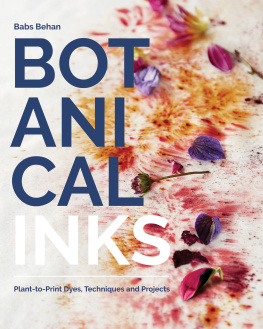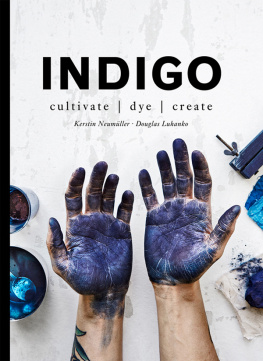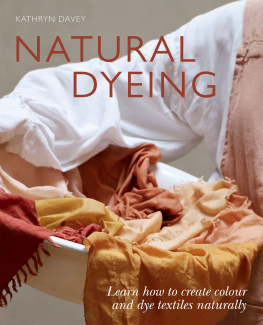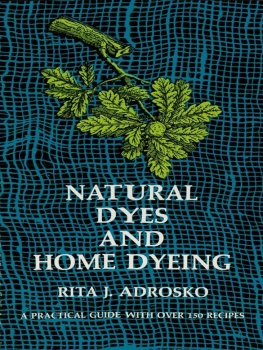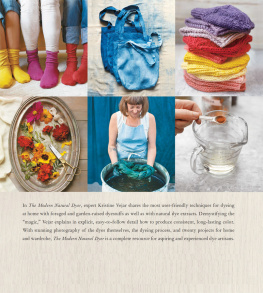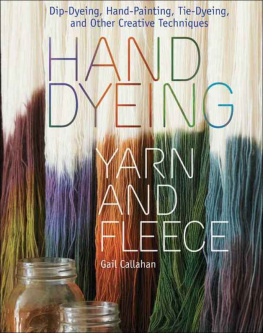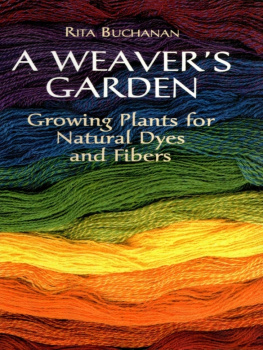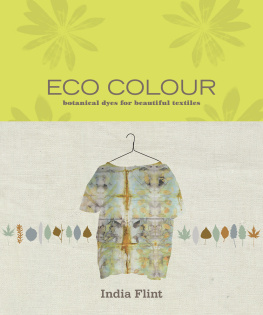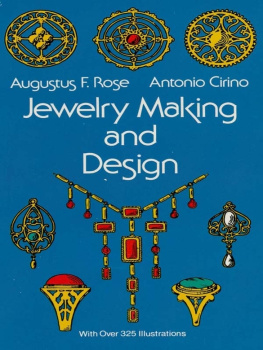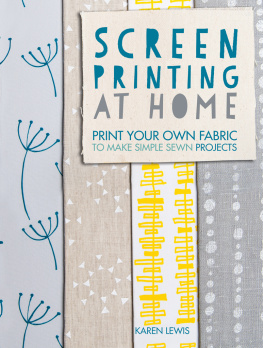CONTENTS
An introduction to natural dyeing
How to choose the fibre and fix the dye
How to make and use a dye bath
Understanding dye materials and the colours they produce
Learn how to apply colour and print, from bundle dyeing to screen printing
Combine your skills to make beautiful accessories and homewares
THE AUTHOR
I first became aware of natural dyeing and printing processes when a friend told me about a vegetable dye block-printing factory in India. I had studied BA Surface Design at the University of the Arts London, but was concerned about all the synthetic chemicals that were used, which got on my skin and offset into the air. When I arrived at the studio each day I was hit by a wall of toxic vapour and it didnt feel safe to be working in this way for long periods of time. I wanted to find a more sustainable and natural way forward, so I arranged an internship in Jaipur, India, at the factory my friend had visited. It turned out to be a fascinating and life-changing experience.
Murghal-style block printing has an elegant look: hand-carved teak blocks and vegetable inks create delicate prints on cloth and Khadi paper. Its a practice that has been handed down through generations, but is now mostly a vanishing tradition due to the increasing demand for synthetic screen- and roll-printing. I fell in love with the quality of line the wooden blocks produced, the earthy colours of the syrupy plant dyes, the skill of the artisans and the sophistication of their hand-crafted work.
I learned how to carve wooden blocks based on my own illustrations, to play with repeat patterns and to use vegetable inks on cotton and silk. I also discovered the vintage silk sari recycling industry, which seemed a more sustainable way to produce clothing using cloth that already existed and had a second life left in it, rather than creating more. This led me to create a clothing line that focused on using natural fibres and recycling vintage cloth into colourful, expressive, bohemian garments, which I sold through independent boutiques in the UK.
Meanwhile, I travelled to explore other cultures and different ways of living and seeing the world and I was fascinated to find that dyeing using plant materials is still thriving in many areas. Everywhere I went, I learned what I could about the natural dyes specific to each place. In Laos, I made dyes using madder and indigo, and dyed skeins of peace silk with traditional textile institution Ock Pop Tok to make the most lustrous shades of blood red and midnight blue. In the Sacred Valley of Peru, I stayed for a week with a Quetchuan master dyer in his family home at 2,000 metres altitude, where we brewed large cauldrons of plant material into vibrant shades of bright pink, soft turquoise, deep green, scarlet red and mustard yellow. In Indonesia, I explored batik painting with wax on bolts of cotton. In southern India, I learned about their natural dyeing and weaving industry.
After six years of the travelling artisan lifestyle, I was ready for a change. International supply chains no longer made any sense to me instead I dreamed of the re-emergence of a local manufacturing system, using locally sourced fibre and natural plant dyes. I spent the summer of 2013 on an artist residency in the Cotswolds, developing a palette of dyes made from local hedgerow plants. I loved the magic of creating colour from the plants around me, infused with their unique herbal essences. I created clothing that spoke of the land; my wardrobe became filled with meaningful garments, which gave me a sense of place and felt restorative and empowering, like herbal charms. I began to teach what I had learned to others, sharing with them the pleasure of foraging plants for colour and connecting with nature in a new and interesting way.
This led me to found Botanical Inks, an artisan natural dye studio based in Bristol, England. The studio specialises in creating organic, naturally dyed and printed cloth and paper for local designers, and offers workshops in contemporary and traditional dyeing and printing techniques. My intention is to raise awareness of the ecological and social issues involved in making things, and to provide viable non-toxic, low-impact solutions.
Botanical Inks allows me to demonstrate what is possible with natural materials and techniques. And ultimately, I hope that this work can encourage cultural change in the way we create things. That we will re-adopt some of the old tried and tested processes, and combine them with our contemporary skills and technology, so that we can work in a way that is more responsible for people and planet.
BOTANICAL INKS
There is so much joy that comes from colour and nature. My studio, Botanical Inks, was founded in order to explore what's available in the natural world, and to reduce the impact of the textile and creative industries on the environment and people.
Botanical Inks first began by offering workshops in the natural dye techniques I had learned and developed from my travels, with an emphasis on using materials and tools that are of the earth, are safe to work with and that can safely be put back into the earth at the end of their useful lifecycle. I like to work with local farmers, growers, weavers and mills to source and use 100% organic, natural dyes, mordants, cloth and paper. I also use natural fibre tools, such as wooden printing blocks, brushes and string. The people who attend the workshops seem to respond to these holistic, authentic practices and this way of extracting colours from plants. They feel inspired by making natural dyes, paints, drawing and printing inks, and using them in textile and paper surface design techniques.
Understanding the natural colour palette of a particular bio-region, and creating art with materials that you have made with your own hands and from the plants that grow around you, can be an incredibly enriching, empowering and connective experience. There is something simple and beautiful about walking out onto the land and picking up fallen leaves, harvesting flowers and berries, and digging up muddy roots, and then soaking them in water to extract their colour.
I have seen people falling in love over and over again with these old-new ways of creating something they love the fact that bringing more beauty into the world neednt be harmful to the environment or to their own personal health.
I have a drive to share these skills, because they are otherwise not easily found. I want to make it easier for others to use natural materials for their creative pursuits, and for those in industry to see that it is commercially viable for their work, too.
Following the popularity of the workshops, Botanical Inks started creating limited-edition handmade naturally dyed products and bespoke services. These include bundle-dyed silk scarves; a bridal bouquet recycling service to make silk lingerie and keepsakes; waste food-dyed table linens; wild writing inks; and block-printed gift cards. These not only add something radical to the marketplace and challenge the status quo, but also demonstrate the high level of sustainable practice that is really possible in the UK.

